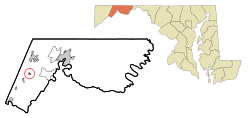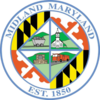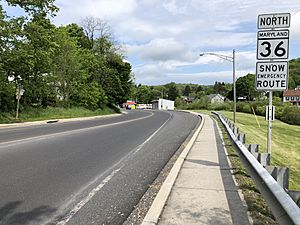Midland, Maryland facts for kids
Quick facts for kids
Midland
|
||
|---|---|---|
|
||

Location of Midland, Maryland
|
||
| Country | ||
| State | ||
| County | ||
| Incorporated | 1900 | |
| Area | ||
| • Total | 0.16 sq mi (0.41 km2) | |
| • Land | 0.16 sq mi (0.41 km2) | |
| • Water | 0.00 sq mi (0.00 km2) | |
| Elevation | 1,713 ft (522 m) | |
| Population
(2020)
|
||
| • Total | 488 | |
| • Density | 3,088.61/sq mi (1,192.74/km2) | |
| Time zone | UTC-5 (Eastern (EST)) | |
| • Summer (DST) | UTC-4 (EDT) | |
| ZIP code |
21542
|
|
| Area code(s) | 301, 240 | |
| FIPS code | 24-52475 | |
| GNIS feature ID | 2391301 | |
Midland is a small town in Allegany County, Maryland, in the United States. It's located in the Georges Creek Valley, a beautiful area. Midland is also part of the larger Cumberland metropolitan area. In 2020, about 488 people lived here. Midland started as a town for coal miners in 1850. Today, there's still a little bit of coal mining, but it's not the main activity anymore.
Contents
Exploring Midland's Location
Midland is a small town with a total area of about 0.41 square kilometers (0.16 square miles). This whole area is land.
The town of Midland sits high up, about 522 meters (1,713 feet) above sea level. It is located about 8 kilometers (5 miles) south of Frostburg. It's also about 5 kilometers (3 miles) north of Lonaconing. Two small streams, Paradise Run and Neff's Run, flow from Dan's Mountain into Georges Creek. Squirrel Neck Run flows into Georges Creek from Savage Mountain.
Just a few miles outside of town, you can find a cool spot called Dan's Rock. From there, you can see the eastern part of the county. You can also see parts of nearby West Virginia. It's a great place for a view!
Towns and Cities Near Midland
Midland is close to several other communities. These include:
- Cumberland
- Lonaconing
- Frostburg
- Barton
- Cresaptown-Bel Air
- Westernport
- Piedmont, West Virginia
- LaVale
- Keyser, West Virginia
People Living in Midland
| Historical population | |||
|---|---|---|---|
| Census | Pop. | %± | |
| 1910 | 1,173 | — | |
| 1920 | 910 | −22.4% | |
| 1930 | 865 | −4.9% | |
| 1940 | 935 | 8.1% | |
| 1950 | 889 | −4.9% | |
| 1960 | 737 | −17.1% | |
| 1970 | 665 | −9.8% | |
| 1980 | 601 | −9.6% | |
| 1990 | 574 | −4.5% | |
| 2000 | 473 | −17.6% | |
| 2010 | 446 | −5.7% | |
| 2020 | 488 | 9.4% | |
| U.S. Decennial Census | |||
Every ten years, the United States counts its population. This is called a census. The census helps us understand how many people live in different places.
Midland's Population in 2010
In the 2010 census, there were 446 people living in Midland. Most people living in Midland were White, making up about 98.4% of the population. A small number of people were African American or from other races. About 0.9% of the population identified as Hispanic or Latino.
The average age of people in Midland was about 43 years old. About 19% of the residents were under 18 years old. About 20% were 65 years or older. The town had a nearly equal number of males and females.
Places of Worship in Midland
Midland has two churches. These are St. Joseph's Catholic Church and Grace United Methodist Church. Both churches were built in 1891.
Getting Around Midland
The main way to travel to and from Midland is by road. The most important road is Maryland Route 36. This road goes north to Frostburg and connects to Interstate 68. It also goes south to Westernport. Another road, Maryland Route 936, also serves the town. This route is a bit slower but offers a more direct path between Midland and Frostburg. Maryland Route 936 used to be the main part of Maryland Route 36.
Famous People from Midland
- Suzanne Rogers is an actress who was born in Midland. She has played the character of Maggie Simmons Horton on the TV show Days of Our Lives since 1973.
See also
 In Spanish: Midland (Maryland) para niños
In Spanish: Midland (Maryland) para niños





